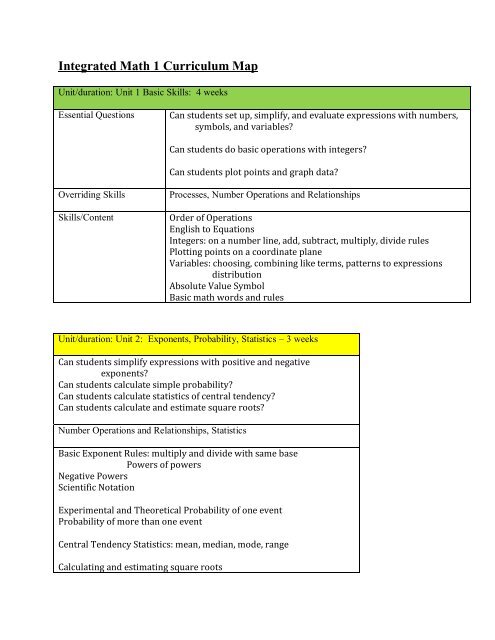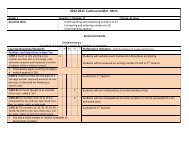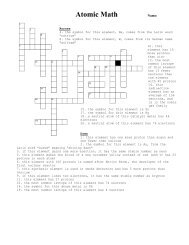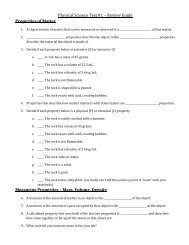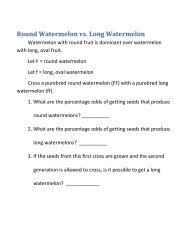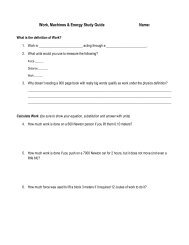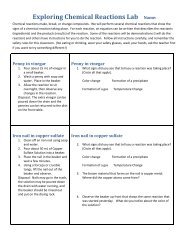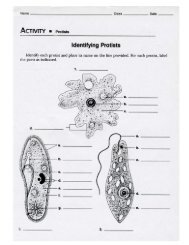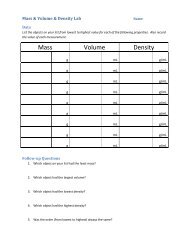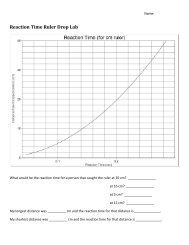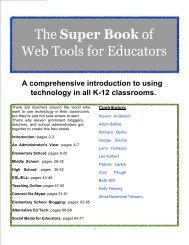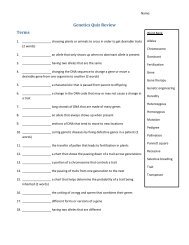Integrated Math 1 Curriculum Map
Integrated Math 1 Curriculum Map
Integrated Math 1 Curriculum Map
Create successful ePaper yourself
Turn your PDF publications into a flip-book with our unique Google optimized e-Paper software.
<strong>Integrated</strong> <strong>Math</strong> 1 <strong>Curriculum</strong> <strong>Map</strong>Unit/duration: Unit 1 Basic Skills: 4 weeksEssential QuestionsCan students set up, simplify, and evaluate expressions with numbers,symbols, and variables?Can students do basic operations with integers?Can students plot points and graph data?Overriding SkillsSkills/ContentProcesses, Number Operations and RelationshipsOrder of OperationsEnglish to EquationsIntegers: on a number line, add, subtract, multiply, divide rulesPlotting points on a coordinate planeVariables: choosing, combining like terms, patterns to expressionsdistributionAbsolute Value SymbolBasic math words and rulesUnit/duration: Unit 2: Exponents, Probability, Statistics – 3 weeksCan students simplify expressions with positive and negativeexponents?Can students calculate simple probability?Can students calculate statistics of central tendency?Can students calculate and estimate square roots?Number Operations and Relationships, StatisticsBasic Exponent Rules: multiply and divide with same basePowers of powersNegative PowersScientific NotationExperimental and Theoretical Probability of one eventProbability of more than one eventCentral Tendency Statistics: mean, median, mode, rangeCalculating and estimating square roots
Unit/duration: Unit 3: Basic Geometry: 4 weeksCan students describe a geometric picture / figure using words andsymbols?Can students find measures on a geometric picture with calculations ormeasurement tools?Can students check solutions to equations and inequalities?Can students describe slope from a graph?Can students draw a graph with a given slope?Can students graph all solutions to an inequality on a number line?Can students draw in symmetry lines on figures?Spatial Thinking, Algebraic RelationshipsBasic Geometry vocabulary and symbolsRuler and protractor useAngle relationshipsGiven an equation or inequality: CHECK if a number is a solutionGraph all solutions to an inequality on a number lineGive the slope from a pictureDraw a picture to fit a given slopeDraw in symmetry lines on figuresSlopes of Parallel and Perpendicular LinesUnit/duration: Unit 4: Solving equations: 5 weeksCan students solve and check algebra equations with one variable?Can students solve and check equations with power of 2 or squareroot?Can students use the Pythagorean Theorem?Can students set up equations from story problems or geometrysituations and solve?Processes, Algebraic RelationshipsSolve linear equations with:1 step, 2 steps, multiple steps, distributionSolve equations with x 2 or square rootsSolve for triangle lengths with Pythagorean theoremSolve story problems with Pythagorean theoremWrite and use equations from real life situationsWrite and solve equations from English sentences
Unit/duration: Unit 5: Area and Perimeter: 5 weeksEssential QuestionsOverriding SkillsSkills/ContentCan students identify types of quadrilaterals?Can students draw in heights on various figures?Can students calculate perimeter and area of quadrilaterals, triangles,circles?Can students apply strategies to find area of compound shapes andshaded regions of shapes?Can students apply area and perimeter to practical situations?Can students work backwards from the answer to find missing parts ofthe figure?Spatial Thinking, Algebraic RelationshipsTypes of Quadrilaterals: rectangle, square, parallelogram, rhombus,trapezoidDraw in Heights: with note card, on graph paperBasic area calculationsUsing addition and subtraction of areas to find area of complex shapesUsing area to solve real life problemsUse algebra and the formulas to start with the answer (area orperimeter) and work backwards to find a missing part.Calculate geometric probabilityUnit/duration: Unit 6: Equations of Lines – 4 weeksEssential QuestionsOverriding SkillsSkills/ContentCan students find and graph equations of lines?Can students calculate slope and intercepts of lines?Can students apply line skills to data?Can students find solutions to a system of equations from a graph?Spatial Thinking, Algebraic RelationshipsSlope-intercept form of lineWriting equations of horizontal, vertical, and oblique lines fromgraphsGraphing equations of linesCalculating slope from ordered pairs, identify type of lineCalculating equations of lines from ordered pairsCalculating x and y intercepts from equationsUsing algebra to change an equation of a line into slope-intercept formLinear Experiments: Identifying and setting up variablesCollecting and graphing dataFinding line of best-fit and calculating equationUsing this equation to make predictions
Unit/duration: Unit 7: Ratios, Proportions, Percents: 4.5 weeksEssential QuestionsCan students set up and apply ratios?Can students set up and apply percents?Can students set up and solve proportions?Overriding SkillsSkills/ContentNumber operations and relationships, StatisticsWriting ratiosApplying ratios: unit price, unit rates, food labelsWriting percents: increase, decreaseApplying percents: tax, sales, tipSolving equations with proportions: shortcut, algebraApplying proportions: Story ProblemsSimilar FiguresPredictions from probabilityCircle graphsUnit/duration: Unit 8: Misc: depend on time…Can students graph equations by hand?Can students solve basic systems of equations with substitution andelimination?Can students multiply binomials?Can students find equations of exponentials?Can students identify 3-d objects?Can students calculate volume and surface area of basic 3-d shapes?Processes, Spatial Thinking, Statistics, Algebraic RelationshipsGraphing equations by hand: cubic, parabolas, hyperbolas, absolutevalueMultiplying binomials: area modelSolving systems of equations with substitutionSolving systems of equations with eliminationExploring exponential equations: parts, graphsSetting up equations of exponentials from story problems or dataIdentifying 3-d objects and their important partsCalculating volume and surface area of 3-d objects –formulas, measuring


